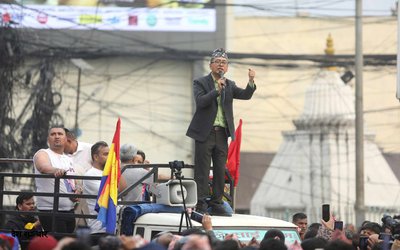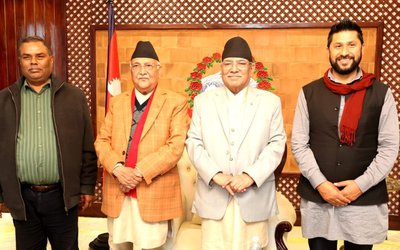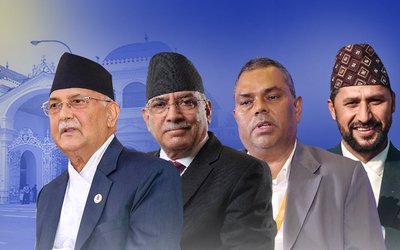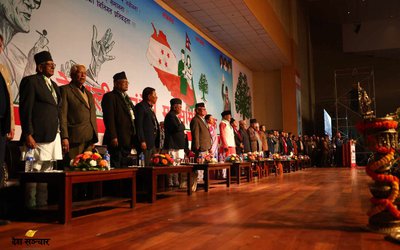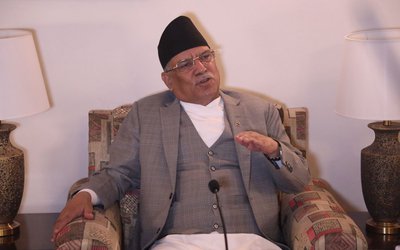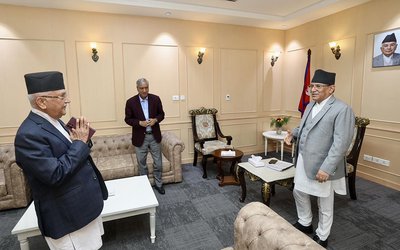Unlike in the past when the National Democratic Day used to be celebrated with mass gatherings of the people from all walks of life in the open space, Nepal celebrated the 63rd Democracy Day in an auditorium of the City Hall, which could seat only a crowd of 800 people.
February 18 was an historic day that ended 104 years of Rana rule and established the first democratic government. This was the day when late King Tribhuwan returned from his exile in India with the Delhi Compromise. Holding the elections for the Constituent Assembly was one of the important components of the Delhi Deal.
Although president prime minister Baburam Bhattarai, key product of political change brought about by the 12-point agreement signed in New Delhi in 2005, was present at the program, there was neither any enthusiasm not a real commitment to promote the democratic culture. In the crowded room, they spoke about the need to strengthen democracy without expressing how democracy and people’s rights would essentially be restored.
“The people need to be aware about their rights. We have already sacrificed lives to arrive at the present state of openness and democracy,” said president Dr. Ram Baran Yadav. “After drafting the new constitution, we will institutionalize democracy.”
Election is the heart of democracy. However, the president, prime minister and leaders of political parties are far from being able to guarantee the people’s right to vote, without which, speeches calling for strengthening democracy sound just like a mockery. The people have supported the political parties to choose their representatives through elections. However, this is the right people are yet to enjoy in a periodic basis like the citizens of its neighbor, India, can enjoy. After elections to the parliament of 1998, the people have waited for ten long years to cast the vote for Constituent Assembly. Due to the lack of the provision to periodic elections, even after almost five years, no signs of elections were in the horizon.
For the past sixty years, an intense political instability has been a regular character of Nepali politics. Although Nepal faced over half a dozen of bloody insurgencies, the ten years of Maoist insurgency brought a casualty of over 15,000 dead and thousands injured, and a major loss in property between 1996 and 2010. The insurgency of 1950 restored King Tribhuwan by overthrowing Rana rule. However, the Maoist insurgency concluded by wiping out monarchy in 2008.
Despite all kinds of deals, Nepal is yet to have a state of political stability. Looking at the current political trend, it seems that the forces of instability remain strong, having a capability to rock any political system and constitution.
“We cannot accept the deal made by four political parties. We will pull them out from streets,” said Pampha Bhushal, spokesperson of CPN-Maoist. “An overwhelming number of people have supported our position.”
The latest example is the alliance of four fringe radical parties against the four major parties. Led by CPN-Maoist, a breakaway faction of UCPN-Maoist, the street of Kathmandu was completely paralyzed due to the general strike called by them opposing the agreement made by four political parties to recommend a CJ-led caretaker election government.
Along with the radical communists in the fringe, a dozen smaller parties in the ruling alliance, dissenters of Nepali Congress, CPN-UML, Madhesh based fringe parties including Madheshi Janadhikar Forum Nepal, Civil Society members and Nepal Bar Association stood against the decision to appoint sitting chief justice to lead the government.
This indicated that like in the past streets are regarded as an important place to challenge the legitimacy than to take part in the elections. Nepal’s all constitutions were thrown out from streets: the first Interim Constitution 2007, 2015 Constitution of Kingdom of Nepal, 2019 Constitution of Nepal, Constitution of Kingdom of Nepal 1990 and Interim Constitution 2006.
In the name of democracy, Nepal has experimented five constitutions and three political systems in the last sixty two years, what is not guaranteed is the right to take part in the periodic elections to elect the representatives.
Elections in Nepal
Elections Under Parliamentary System
1. 1959
2. 1991
3. 1994
4. 1998
5. 2008 (Constituent Assembly)
Elections Under Panchayat, including indirect elections for Rastriya Panchayat (National Council)
6. 2023 (Direct for graduate and class organizations)
7. 2028 (direct for graduate and other class organizations and indirect for others)
8. 2032 (Nomination and Consensus)
9. 1980 (National Referendum)
10. 1981 (Direct elections for Rastriya Panchayat)
11. 1986 (Direct elections for Rastriya Panchayat)
Local Elections
Direct Local elections of District Panchayat, Nagar (Municipality) and Gaun (Village) Panchayat,
12. 1948 (Direct)
13. 1965 (Direct)
14. 1970 (Direct)
15. 1976 (Consensus)
16. 1982 (Direct)
17. 1987 (Direct)
18. 1993 (Direct under Multiparty system)
19. 1998 (Direct under Multi-party system)
20. 2005 (Boycotted by Major parties)

Keshab Poudel
Poudel is the editor of New Spotlight Magazine.
- ECONOMY: Growth At 3.3
- Apr 16, 2024
- DPM’s SHRESTHA’S CHINA VISIT High Profile, Low Key
- Apr 14, 2024
- Maha Kumbha In Barahkshetra: A Sacred Festival In Sacred Koshi (Kaushiki) River
- Apr 09, 2024
- LOSS AND DAMAGE: Upper Tamakoshi A Case
- Apr 02, 2024
- Helvetas-Nepal’s InElam Promoting Herbal Oil In Sarlahi
- Mar 31, 2024

